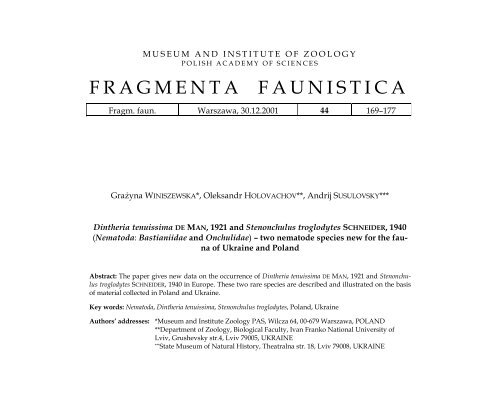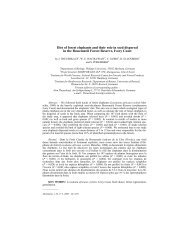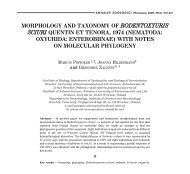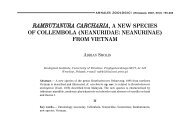MUSEUM & INSTITUTE OF ZOOLOGY
MUSEUM & INSTITUTE OF ZOOLOGY
MUSEUM & INSTITUTE OF ZOOLOGY
Create successful ePaper yourself
Turn your PDF publications into a flip-book with our unique Google optimized e-Paper software.
<strong>MUSEUM</strong> AND <strong>INSTITUTE</strong> <strong>OF</strong> <strong>ZOOLOGY</strong><br />
POLISH ACADEMY <strong>OF</strong> SCIENCES<br />
FRAGMENTA FAUNISTICA<br />
Fragm. faun. Warszawa, 30.12.2001 44 169–177<br />
Grażyna WINISZEWSKA*, Oleksandr HOLOVACHOV**, Andrij SUSULOVSKY***<br />
Dintheria tenuissima DE MAN, 1921 and Stenonchulus troglodytes SCHNEIDER, 1940<br />
(Nematoda: Bastianiidae and Onchulidae) – two nematode species new for the fauna<br />
of Ukraine and Poland<br />
Abstract: The paper gives new data on the occurrence of Dintheria tenuissima DE MAN, 1921 and Stenonchulus<br />
troglodytes SCHNEIDER, 1940 in Europe. These two rare species are described and illustrated on the basis<br />
of material collected in Poland and Ukraine.<br />
Key words: Nematoda, Dintheria tenuissima, Stenonchulus troglodytes, Poland, Ukraine<br />
Authors’ addresses: *Museum and Institute Zoology PAS, Wilcza 64, 00-679 Warszawa, POLAND<br />
**Department of Zoology, Biological Faculty, Ivan Franko National University of<br />
Lviv, Grushevsky str.4, Lviv 79005, UKRAINE<br />
*** State Museum of Natural History, Theatralna str. 18, Lviv 79008, UKRAINE
<strong>MUSEUM</strong> AND <strong>INSTITUTE</strong> <strong>OF</strong> <strong>ZOOLOGY</strong><br />
POLISH ACADEMY <strong>OF</strong> SCIENCES<br />
FRAGMENTA FAUNISTICA<br />
Fragm. faun. Warszawa, 30.12.2001 44 179–201<br />
S. I. GOLOVATCH*, R. L. H<strong>OF</strong>FMAN**, S. KNAPINSKI*** and J. ADIS***<br />
Review of the millipede genus Cylindrodesmus POCOCK, 1889 (Diplopoda:<br />
Polydesmida: Haplodesmidae)<br />
Abstract: The genus Cylindrodesmus seems to actually comprise only two unquestioned species, (1) C. hirsutus<br />
POCOCK, 1889 (the type species), a pantropical anthropochore with bisexual populations, usually referred to as<br />
C. hirsutus, living in various places in the tropics, and parthenogenetic populations, normally referred to as C.<br />
laniger SCHUBART, 1944, occurring in numerous places in the tropics as well as in a few European hothouses,<br />
and (2) C. villosus POCOCK, 1898, from Rotuma Island, Pacific Ocean. Lectotypes of C. hirsutus, C. villosus as well<br />
as of C. palmyrae CHAMBERLIN, 1954, the latter a long-established junior synonym of C. laniger, have been selected,<br />
illustrated and discussed. As there are obviously no characters that would allow to distinguish C. laniger<br />
from C. hirsutus other than those apparently related to parthenogenesis, e.g. generally smaller body size, normally<br />
a bit more strongly falcate/sigmoid gonopods in the residual males, and the vulvae devoid of welldeveloped<br />
receptacula seminis, the following new synonym is proposed: C. hirsutus POCOCK, 1889 = C. laniger<br />
SCHUBART, 1944, syn.n. Revision of the types of Inodesmus peduncularis LOOMIS, 1934, from Surinam, also results<br />
in its formal synonymy under C. hirsutus, syn.n. It is certainly because of the numerous C. hirsutus populations<br />
being thelytokous, more or less devoid of males, that this species, and genus, has a pretty long list of synonymies.<br />
In addition, Elatosus CHAMBERLIN, 1945, monobasic, with E. pygmaeus CHAMBERLIN, 1945, from Java, is<br />
herewith formally synonymized with Cylindrodesmus, and E. pygmaeus with C. hirsutus, both syn.n.<br />
Key words: Diplopoda, Cylindrodesmus, taxonomy, new synonymy, anthropochorism, parthenogenesis<br />
Authors’ addresses: *Institute for Problems of Ecology and Evolution, Russian Academy of Sciences,<br />
Leninsky prospekt 33, Moscow 117071 (V-71), RUSSIA<br />
**Virginia Museum of Natural History, 1001 Douglas Ave., Martinsville 24112,<br />
Viginia, U.S.A.<br />
***Max-Planck-Institute for Limnology, Tropical Ecology Working Group, August-<br />
Thienemann-Str. 2, D-24306 Plön, GERMANY
<strong>MUSEUM</strong> AND <strong>INSTITUTE</strong> <strong>OF</strong> <strong>ZOOLOGY</strong><br />
POLISH ACADEMY <strong>OF</strong> SCIENCES<br />
FRAGMENTA FAUNISTICA<br />
Fragm. faun. Warszawa, 30.12.2001 44 203–212<br />
Dariusz SKARŻYŃSKI<br />
Springtails (Collembola) of the Karkonosze Mountains (Poland)<br />
Abstract: Faunistic studies in the Polish part of the Karkonosze Mts (W Sudetes) have revealed 128 species,<br />
including 5 species new to the fauna of the Sudetes and 41 species new to the fauna of the Karkonosze Mts.<br />
The total number of Collembola species of the Karkonosze Mts is 145, including species recorded in earlier<br />
studies. The author distinguished six zoogeographical elements in the Collembola fauna of the Karkonosze<br />
Mts: widely distributed, montane, Boreal-montane, Arctic-montane, Circumpolar and endemic. The fauna<br />
of springtails of the Karkonosze Mts is roughly comparable to the fauna of East Sudetes with a relatively<br />
high proportion of cavicolous and ripicolous species.<br />
Key words: Collembola, fauna of the Karkonosze Mountains, Sudetes, Poland<br />
Authors’ address: Zoological Institute, Wrocław University, Sienkiewicza 21, 50-335 Wrocław, POLAND;<br />
mail: hypogast@biol.uni.wroc.pl
<strong>MUSEUM</strong> AND <strong>INSTITUTE</strong> <strong>OF</strong> <strong>ZOOLOGY</strong><br />
POLISH ACADEMY <strong>OF</strong> SCIENCES<br />
FRAGMENTA FAUNISTICA<br />
Fragm. faun. Warszawa, 30.12.2001 44 213–227<br />
Franz W. QUEDNAU * and Seung H. LEE **<br />
An annotated list of drepanosiphine aphids (Hemiptera: Aphidoidea) from Korea.<br />
Part I: Saltusaphidinae to Calaphidinae from South Korea with the description of a<br />
new species<br />
Abstract: A total of 53 aphid species from South Korea are listed in the subfamilies Saltusaphidinae,<br />
Phyllaphidinae, Drepanosiphinae and Calaphidinae. The alate morph and embryo of Saltusaphis tuberculata n. sp.<br />
are described. This species is closely related to S. scirpus Theobald, but differs by the presence of wart-like<br />
spinal processes on the abdomen and by its hair-like pointed, not flabellate, dorsal body setae. Twenty<br />
aphid species are recorded for the first time on the Korean Peninsula.<br />
Key words: Hemiptera, Aphidoidea, drepanosiphine aphids, new species, South Korea<br />
Authors’ addresses: *Natural Resources Canada, Canadian Forest Service, Laurentian Forestry Centre,<br />
1055 du P.E.P.S., P.O. Box 3800, Sainte-Foy, Quebec, CANADA G1V 4C7; e-mail:<br />
fquednau@cfl.forestry.ca<br />
**Division of Entomology, National Institute of Agricultural Science and Technology<br />
(NIAST), Suwon 441-707, KOREA; e-mail: seunglee@rda.go.kr
<strong>MUSEUM</strong> AND <strong>INSTITUTE</strong> <strong>OF</strong> <strong>ZOOLOGY</strong><br />
POLISH ACADEMY <strong>OF</strong> SCIENCES<br />
FRAGMENTA FAUNISTICA<br />
Fragm. faun. Warszawa, 30.12.2001 44 229–249<br />
Katarzyna GOLAN*, Bożena ŁAGOWSKA** and Bożenna JAŚKIEWICZ*<br />
Scale insects (Hemiptera, Coccoidea) of the Kazimierz Landscape Park in Poland<br />
Abstract: The studies were carried out in the years 1988–1991 and 1996–1998 in the Kazimierz Landscape<br />
Park in eastern Poland. 63 species, including 57 species that are new for that region and 9 species that are<br />
rare for the Polish fauna were found out in the material gathered during the research. Qualitative, quantitative<br />
and zoogeographical analyses of scale insects groups in various plant communities are presented. The<br />
relations between scale insects and plant communities are discussed. The degree of similarity of the species<br />
composition in plant communities is determined.<br />
Key words: Coccoidea, plant communities, ecological and zoogeographical analysis of groups, Poland<br />
Authors’ addresses: *Department of Entomology, University of Agriculture, K. Leszczyńskiego 7, 20-069<br />
Lublin, POLAND<br />
**Department of Environmental Management, Technical University of Białystok, S.<br />
Tarasiuka 2, 16-001 Kleosin, POLAND
<strong>MUSEUM</strong> AND <strong>INSTITUTE</strong> <strong>OF</strong> <strong>ZOOLOGY</strong><br />
POLISH ACADEMY <strong>OF</strong> SCIENCES<br />
FRAGMENTA FAUNISTICA<br />
Fragm. faun. Warszawa, 30.12.2001 44 251–268<br />
Marcin SMOLEŃSKI<br />
The environmental evaluation by synecological zooindication - a proposal of the<br />
method based on epigeic invertebrate communities x<br />
Abstract: This paper presents an original methodological attempt at natural valorization based on the analysis<br />
of epigeic invertebrate communities. The essence of the method is in determining the proximity of the<br />
real community towards the standard one, the latter elaborated so that it is representative for the ecosystem<br />
of given type. The survey, the assessment of the natural value and the evaluation of the anthropopressure<br />
are all based on the test describing epigeic communities of invertebrates with the use of seven indices: I. Per<br />
cent share: (1) per cent share of characteristic - exclusive species F3; and total of characteristic exclusive and<br />
choosing species F3+F2; (2) the index of community uniqueness Sc; (3) the index of community stability Nc;<br />
(4) the index of species diversity H’; (5) the index of community natural quality Bc; (6) the index of dynamic<br />
heterogeneity DHt; (7) the index of habitat species capacity Pc<br />
Key words: natural valorization, zooindication, indices, method, epigeic communities, invertebrates<br />
Author’s address: Museum and Institute of Zoology PAS, Wilcza 64, 00-679 Warszawa, POLAND
<strong>MUSEUM</strong> AND <strong>INSTITUTE</strong> <strong>OF</strong> <strong>ZOOLOGY</strong><br />
POLISH ACADEMY <strong>OF</strong> SCIENCES<br />
FRAGMENTA FAUNISTICA<br />
Fragm. faun. Warszawa, 30.12.2001 44 269–300<br />
Marcin SMOLEŃSKI<br />
The environmental evaluation of coastal pine forests of the Łebsko sand bar by<br />
zooindication based on epigeic staphylinid communities (Coleoptera,<br />
Staphylinidae) x<br />
Abstract: The coastal pine forest bioindication has been carried out with use of epigeic staphylinid communities<br />
and applying the test containing seven zooindicative indices. The empirical standard of Empetro nigri<br />
Pinetum epigeic communities of staphylinids enabled the natural value valorization and man-made changes<br />
assessment in the ecosystem. The natural valorization of coastal pine forest of the Mierzeja Łebska sand bar<br />
has been based on the four indices: the index of uniqueness Sc, natural quality Bc, equability J' and general<br />
species diversity H'. The system of natural valorization discriminates the ecosystems into six valorization<br />
classes: from the most valuable to the poorest one.<br />
Key words: natural valorization, zooindication, communities, Staphylinidae, Empetro-nigri pinetum – coastal<br />
pine forest, Słowiński National Park<br />
Author’s address: Museum and Institute of Zoology PAS, Wilcza 64, 00-679 Warszawa, POLAND
<strong>MUSEUM</strong> AND <strong>INSTITUTE</strong> <strong>OF</strong> <strong>ZOOLOGY</strong><br />
POLISH ACADEMY <strong>OF</strong> SCIENCES<br />
FRAGMENTA FAUNISTICA<br />
Fragm. faun. Warszawa, 30.16.2001 44 301–308<br />
Marcin SMOLEŃSKI<br />
The use of similarity analysis in the environmental research – a case study of<br />
multispecies invertebrate communities x<br />
Abstract: Similarity analysis was carried out with use of two techniques, the Ward method and Renkonen<br />
method, in order to analyze staphylinid (Coleoptera: Staphylinidae) epigeic communities of the coastal pine<br />
forest. This attempt enabled a multilateral spatial description of the coastal pine forest microsite structure<br />
including the domination structure of microsites, the degree of their isolation, and the migration impact and<br />
edge effect of ecotone zones.<br />
Key words: similarity, communities, Staphylinidae, Empetro-nigri Pinetum – coastal pine forest<br />
Author’s address: Museum and Institute Zoology PAS, Wilcza 64, 00-679 Warszawa, POLAND
<strong>MUSEUM</strong> AND <strong>INSTITUTE</strong> <strong>OF</strong> <strong>ZOOLOGY</strong><br />
POLISH ACADEMY <strong>OF</strong> SCIENCES<br />
FRAGMENTA FAUNISTICA<br />
Fragm. faun. Warszawa, 30.12.2001 44 309–317<br />
R. Henry L. DISNEY<br />
Sciadoceridae (Diptera) reconsidered<br />
Abstract: TONNOIR’s (1926) assignment of Sciadocera rufomaculata WHITE to the Phoridae is supported and<br />
SCHMITZ’s (1929) transfer of it and Archiphora patagonica SCHMITZ to a separate family, Sciadoceridae, is<br />
rejected. The growing number of fossils bridging the gap between Sciadoceridae and Phoridae support the<br />
view that the sciadocerids are merely an assortment of Phoridae that share some plesiomorphic features.<br />
Key words: Diptera, Phoridae, Sciadoceridae, Aschiza, systematic position<br />
Author’s address: University Department of Zoology, Downing Street, Cambridge CB2 3EJ, U. K.<br />
e-mail: rhld2@hermes.cam.ac.uk
<strong>MUSEUM</strong> AND <strong>INSTITUTE</strong> <strong>OF</strong> <strong>ZOOLOGY</strong><br />
POLISH ACADEMY <strong>OF</strong> SCIENCES<br />
FRAGMENTA FAUNISTICA<br />
Fragm. faun. Warszawa, 30.12.2001 44 319–328<br />
R. Henry L. DISNEY and Martin D. F. ELLWOOD<br />
An intriguing new genus of scuttle fly (Diptera: Phoridae) from Borneo<br />
Abstract: Dohrnigma nudifrons n. gen., n. sp. is described from Borneo. It seems to represent a transitional<br />
form related to Dohrniphora DAHL. Synaptophora BROWN is transferred to the Diplonevrini, which in turn is<br />
removed from the subfamily Aenigmatiinae.<br />
Key words: Diptera, Phoridae, new genus, new species, Oriental Region, phylogeny.<br />
Authors’ address: University Museum of Zoology, Downing Street, Cambridge CB2 3EJ, UK
<strong>MUSEUM</strong> AND <strong>INSTITUTE</strong> <strong>OF</strong> <strong>ZOOLOGY</strong><br />
POLISH ACADEMY <strong>OF</strong> SCIENCES<br />
FRAGMENTA FAUNISTICA<br />
Fragm. faun. Warszawa, 30.12.2001 44 329–340<br />
R. Henry L. DISNEY* and Marina V. MICHAILOVSKAYA**<br />
New species and new records of Puliciphora DAHL (Phoridae: Diptera) from Russia,<br />
India and the Seychelles<br />
Abstract: Puliciphora taigae n. sp. and P. spirapenis n. sp. are described from the far east of Russia, and P.<br />
puerilis, from Madeira and the Canary Islands, is synonymised with P. borinquenensis. A key to the<br />
Palaearctic species is provided. P. collinsi and P. pulex are reported from India, and the latter from the<br />
Seychelles as well. The hitherto unknown male of the former is described and that of the latter amplified.<br />
Adults of P. tokyoensis emerging in summer were exclusively females, suggesting that facultative<br />
parthenogenesis gives rise to this generation.<br />
Key words: Phoridae, Puliciphora, new species, synonymy, Palaearctic, Oriental, key, parthenogenesis.<br />
Authors’ addresses: * University Museum of Zoology, Downing Street, Cambridge CB2 3EJ, UK<br />
**Mountain Taiga Station, Far Eastern Branch, Russian Academy of Sciences, Gornotayozhnoe,<br />
Primorski krai, 692533, RUSSIA
<strong>MUSEUM</strong> AND <strong>INSTITUTE</strong> <strong>OF</strong> <strong>ZOOLOGY</strong><br />
POLISH ACADEMY <strong>OF</strong> SCIENCES<br />
FRAGMENTA FAUNISTICA<br />
Fragm. faun. Warszawa, 30.12.2001 44 341–351<br />
Waldemar MIKOŁAJCZYK<br />
Mycetophilidae s.l. (Diptera) of linden-oak-hornbeam woods in the Białowieża<br />
National Park<br />
Abstract: Fungus gnats were studied in linden-oak-hornbeam woods, the most representative plant associations<br />
in the Białowieża National Park. The species composition, abundance and frequency of Mycetophilidae<br />
s. l. at three selected sites were compared. 257 species were recorded. Most of the material was collected by<br />
netting, some by light and by odour baits.<br />
Key words: Diptera, Mycetophilidae s.l., linden-oak-hornbeam woods (Tilio-Carpinetum), Białowieża National<br />
Park, Poland.<br />
Author’s address: Museum and Institute Zoology PAS, Wilcza 64, 00-679 Warszawa, POLAND
<strong>MUSEUM</strong> AND <strong>INSTITUTE</strong> <strong>OF</strong> <strong>ZOOLOGY</strong><br />
POLISH ACADEMY <strong>OF</strong> SCIENCES<br />
FRAGMENTA FAUNISTICA<br />
Fragm. faun. Warszawa, 30.12.2001 44 353–356<br />
Dušan CYPRICH*, Jan PINOWSKI**, Miroslav KRUMPÁL*<br />
Occurrence of Ceratophyllus pullatus JORDAN et ROTHSCHILD, 1920 (Siphonaptera)<br />
in Poland<br />
Abstract: About 2000 specimens of fleas (Siphonaptera) were taken from 54 nests of the house sparrow<br />
(Passer domesticus) and 184 nests of the tree sparrow (Passer montanus) in central Poland. Among them,<br />
Ceratophyllus pullatus JORDAN et ROTHSCHILD, 1920, represented by two males, is formally new to the Polish<br />
fauna.<br />
Key words: Ceratophyllus pullatus, Siphonaptera, nest, Passer spp., Aves, central Poland, faunistics<br />
Authors’ addresses: * Department of Zoology, Comenius University, Mlynská dolina B-1, 84215 Bratislava,<br />
Slovak Republic<br />
**Department of Vertebrate Ecology, Institute of Ecology of PAS, 05-092 Łomianki,<br />
Dziekanów Leśny, Poland
<strong>MUSEUM</strong> AND <strong>INSTITUTE</strong> <strong>OF</strong> <strong>ZOOLOGY</strong><br />
POLISH ACADEMY <strong>OF</strong> SCIENCES<br />
FRAGMENTA FAUNISTICA<br />
Fragm. faun. Warszawa, 30.12.2001 44 357–364<br />
Maria WOLAK<br />
Rare spider species (Araneae) in agrocoenoses<br />
Abstract: The spider fauna of four balks in agricultural landscape of Eastern Poland was analysed. Spiders<br />
known as agrobionts were most abundant but a few species rare for Poland were also recorded. Some spiders<br />
immigrated from other unmanaged areas (small woodlands) were found in the balks, indicating that<br />
these habitats act as ecological corridors. An analysis of spider fauna composition reveals that the presence<br />
of balks increases biodiversity in agroecosystems.<br />
Key words: agrocoenoses, balks, organic farming, spiders<br />
Authors’ addresses: Katedra Zoologii, Akademia Podlaska, ul. Prusa 12, 08-110 Siedlce, POLAND;<br />
e-mail: wolak@siedlce.pl
<strong>MUSEUM</strong> AND <strong>INSTITUTE</strong> <strong>OF</strong> <strong>ZOOLOGY</strong><br />
POLISH ACADEMY <strong>OF</strong> SCIENCES<br />
FRAGMENTA FAUNISTICA<br />
Fragm. faun. Warszawa, 30.12.2001 44 365–370<br />
Piotr SKUBAŁA*, Ritva NIEMI**, Izabela MLECZKO***<br />
Oribatid mite fauna of greenhouses in Upper Silesia, Poland<br />
Abstract: Oribatid mites occurring in greenhouses in Gliwice and Sosnowiec (Upper Silesia) from different<br />
vegetation types (tropical, cultivated, desertic, temperate ones) were investigated. In total 1715 oribatids,<br />
representing 58 species, were collected. The oribatid fauna was accidentally established as a result of using<br />
soil from different sources. The oribatid mite communities were poorly developed. Differences in the structure<br />
of oribatid communities were not significant. Furthermore, relationships between oribatids and specific<br />
plant species were not revealed for most oribatids. Eight rare species arriving by passive transport were<br />
collected.<br />
Key words: Oribatida, greenhouses, passive dispersal<br />
Authors’ addresses: *University of Silesia, Department of Ecology, Bankowa 9, 40-007 Katowice,<br />
POLAND; e-mail: pskubala@us.edu.pl;<br />
**University of Turku, Zoological Museum FIN-20014 Turku, FINLAND; e-mail:<br />
ritniemi@utu.fi;<br />
***Warszawska 49/8, 40-010 Katowice, POLAND






